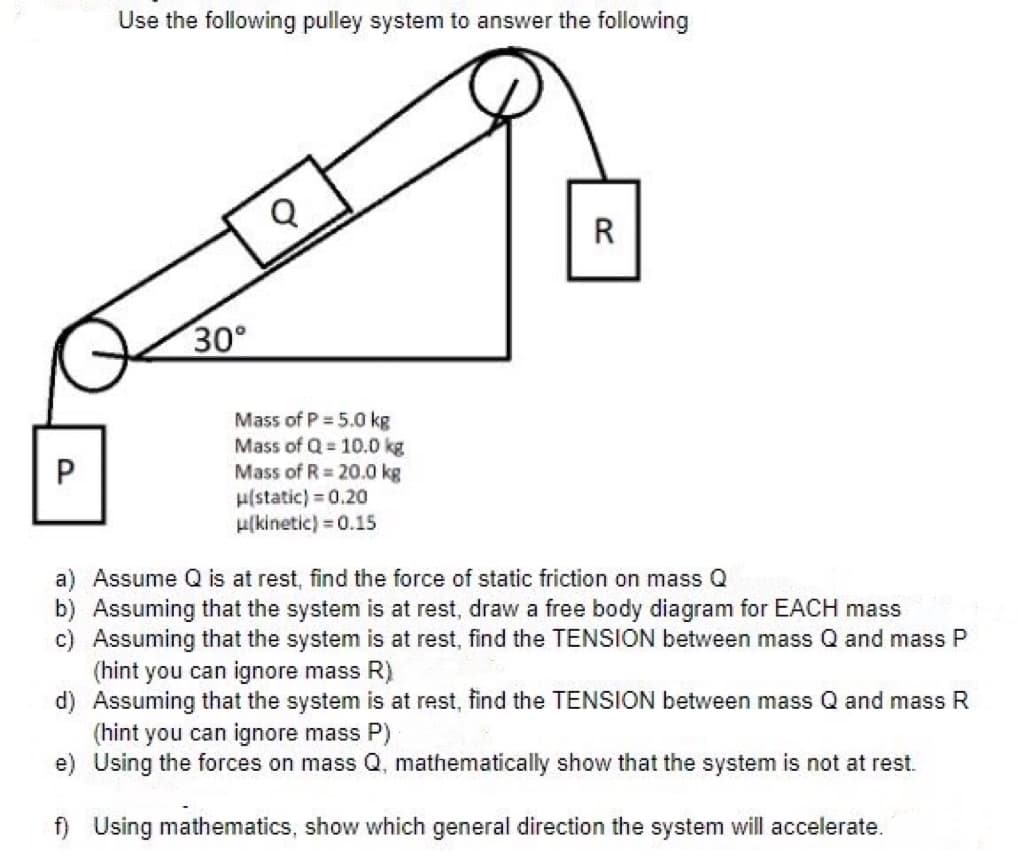R 30° Mass of P = 5.0 kg Mass of Q = 10.0 kg Mass of R = 20.0 kg H(static) 0.20 Hlkinetic) = 0.15 P a) Assume Q is at rest, find the force of static friction on mass Q b) Assuming that the system is at rest, draw a free body diagram for EACH mass c) Assuming that the system is at rest, find the TENSION between mass Q and mass P (hint you can ignore mass R) d) Assuming that the system is at rest, find the TENSION between mass Q and mass R (hint you can ignore mass P) e) Using the forces on mass Q, mathematically show that the system is not at rest. f) Using mathematics, show which general direction the system will accelerate.
R 30° Mass of P = 5.0 kg Mass of Q = 10.0 kg Mass of R = 20.0 kg H(static) 0.20 Hlkinetic) = 0.15 P a) Assume Q is at rest, find the force of static friction on mass Q b) Assuming that the system is at rest, draw a free body diagram for EACH mass c) Assuming that the system is at rest, find the TENSION between mass Q and mass P (hint you can ignore mass R) d) Assuming that the system is at rest, find the TENSION between mass Q and mass R (hint you can ignore mass P) e) Using the forces on mass Q, mathematically show that the system is not at rest. f) Using mathematics, show which general direction the system will accelerate.
College Physics
11th Edition
ISBN:9781305952300
Author:Raymond A. Serway, Chris Vuille
Publisher:Raymond A. Serway, Chris Vuille
Chapter1: Units, Trigonometry. And Vectors
Section: Chapter Questions
Problem 1CQ: Estimate the order of magnitude of the length, in meters, of each of the following; (a) a mouse, (b)...
Related questions
Question

Transcribed Image Text:Use the following pulley system to answer the following
R
30°
Mass of P = 5.0 kg
Mass of Q = 10.0 kg
Mass of R= 20.0 kg
H(static) 0.20
H(kinetic) = 0.15
a) Assume Q is at rest, find the force of static friction on mass Q
b) Assuming that the system is at rest, draw a free body diagram for EACH mass
c) Assuming that the system is at rest, find the TENSION between mass Q and mass P
(hint you can ignore mass R)
d) Assuming that the system is at rest, find the TENSION between mass Q and mass R
(hint you can ignore mass P)
e) Using the forces on mass Q, mathematically show that the system is not at rest.
f) Using mathematics, show which general direction the system will accelerate.
Expert Solution
This question has been solved!
Explore an expertly crafted, step-by-step solution for a thorough understanding of key concepts.
Step by step
Solved in 4 steps with 3 images

Knowledge Booster
Learn more about
Need a deep-dive on the concept behind this application? Look no further. Learn more about this topic, physics and related others by exploring similar questions and additional content below.Recommended textbooks for you

College Physics
Physics
ISBN:
9781305952300
Author:
Raymond A. Serway, Chris Vuille
Publisher:
Cengage Learning

University Physics (14th Edition)
Physics
ISBN:
9780133969290
Author:
Hugh D. Young, Roger A. Freedman
Publisher:
PEARSON

Introduction To Quantum Mechanics
Physics
ISBN:
9781107189638
Author:
Griffiths, David J., Schroeter, Darrell F.
Publisher:
Cambridge University Press

College Physics
Physics
ISBN:
9781305952300
Author:
Raymond A. Serway, Chris Vuille
Publisher:
Cengage Learning

University Physics (14th Edition)
Physics
ISBN:
9780133969290
Author:
Hugh D. Young, Roger A. Freedman
Publisher:
PEARSON

Introduction To Quantum Mechanics
Physics
ISBN:
9781107189638
Author:
Griffiths, David J., Schroeter, Darrell F.
Publisher:
Cambridge University Press

Physics for Scientists and Engineers
Physics
ISBN:
9781337553278
Author:
Raymond A. Serway, John W. Jewett
Publisher:
Cengage Learning

Lecture- Tutorials for Introductory Astronomy
Physics
ISBN:
9780321820464
Author:
Edward E. Prather, Tim P. Slater, Jeff P. Adams, Gina Brissenden
Publisher:
Addison-Wesley

College Physics: A Strategic Approach (4th Editio…
Physics
ISBN:
9780134609034
Author:
Randall D. Knight (Professor Emeritus), Brian Jones, Stuart Field
Publisher:
PEARSON